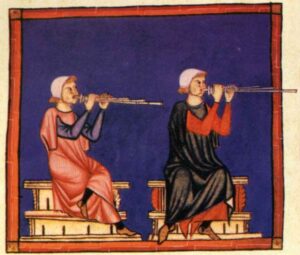Santa Maria, Strela do Dia

The Cantigas de Santa Maria (Canticles to Saint Mary) consist of 420 poems written in the 13th century during the reign of Alfonso X of Castile (The Wise) (r. 1252-1284). These monophonic songs in medieval Galician-Portuguese songs honor the Virgin Mary. The collection was assemble by Alfonso and he himself is generally credited with writing some of the songs. The collection is considered one of the greatest monuments of medieval music.
The style of the music resembles that of the troubadours in France. There were frequent visits between the rulers of the Iberian Peninsula and Provence, and it makes sense that the musical entourages from the two regions would have been present, providing opportunities for some cross-fertilization of ideas.
Alfonso’s kingdom included Castile, León, and Galicia in today’s northwest Spain. Galicia includes one of the primary pilgrimage sites of the late Medieval Era, Santiago di Compostella. From the 10th century on, Pilgrims gathered in France to prepare for their journey along the Way of St. James. A pilgrimage was a serious religious undertaking, usually arduous and often dangerous. Various monasteries served as jumping off points for a trip likely to last months or even years. The pilgrims of course sang songs along the way and many of the cantigas deal explicitly with the theme of pilgrimage.
Santa Maria, Strela do dia (Holy Mary, morning star) is number 100 in the collection. The text and English translation can be found here.



